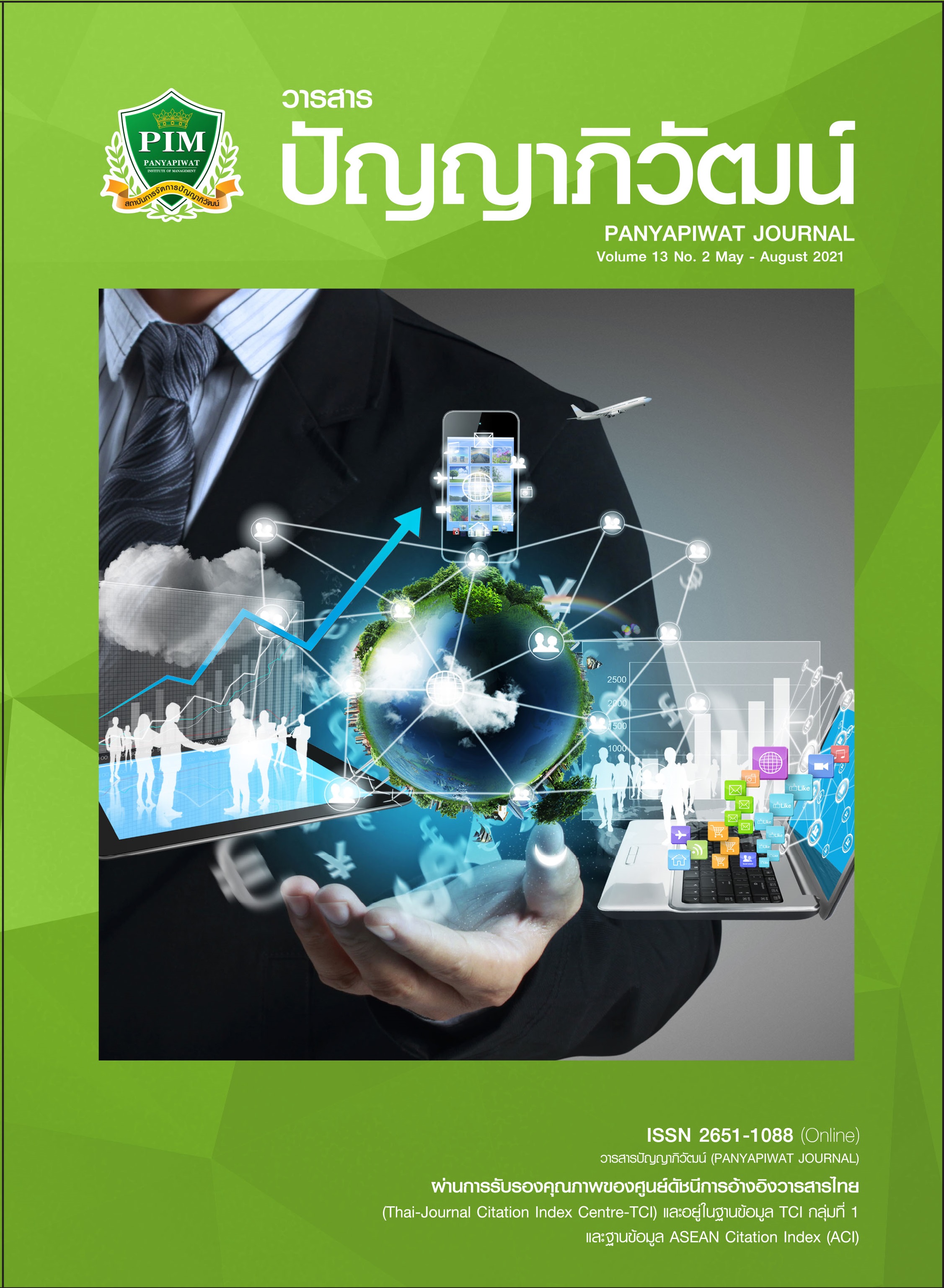แนวทางการพัฒนาศักยภาพและส่งเสริมการตลาดออนไลน์ แหล่งท่องเที่ยวชุมชนเชิงนิเวศในจังหวัดน่าน
Main Article Content
บทคัดย่อ
งานวิจัยนี้มีวัตถุประสงค์เพื่อ 1) ศึกษาศักยภาพแหล่งท่องเที่ยวชุมชนเชิงนิเวศในจังหวัดน่าน 2) ศึกษาและ พัฒนาต้นแบบระบบสนับสนุนการตลาดออนไลน์แหล่งท่องเที่ยวชุมชนเชิงนิเวศในจังหวัดน่านผ่านแอปพลิเคชัน แบบกลุ่มเมฆ 3) เสนอแนะแนวทางการพัฒนาศักยภาพและส่งเสริมการตลาดออนไลน์แหล่งท่องเที่ยวชุมชน เชิงนิเวศในจังหวัดน่าน โดยกำหนดพื้นที่วิจัยในจังหวัดน่าน 2 แห่ง ได้แก่ หมู่บ้านมณีพฤกษ์ อำเภอทุ่งช้าง และ หมู่บ้านห้วยพ่าน อำเภอเชียงกลาง งานวิจัยนี้เป็นงานวิจัยแบบผสมผสานทั้งเชิงคุณภาพและเชิงปริมาณ ประชากร และกลุ่มตัวอย่างคือ ผู้มีส่วนได้ส่วนเสียและภาคีต่างๆ ที่เกี่ยวข้อง เพื่อสัมภาษณ์ เชิงลึกและประชุมกลุ่มย่อย ประกอบด้วยผู้บริหารของหน่วยงานราชการ ภาคเอกชน ภาคชุมชน ภาควิชาการ จำนวน 43 คน โดยใช้เครื่องมือ ที่ปรับปรุงจากแบบประเมินศักยภาพแหล่งท่องเที่ยวเชิงนิเวศของกรมการท่องเที่ยว และเพื่อสอบถามนักท่องเที่ยว เชิงนิเวศที่เกี่ยวกับการท่องเที่ยวการท่องเที่ยวเชิงนิเวศในชุมชน จำนวน 200 คน ระหว่างเดือนมกราคมถึงเมษายน 2561 การวิเคราะห์ข้อมูลเชิงปริมาณเป็นการวิเคราะห์เชิงพรรณนา และการวิเคราะห์ข้อมูลเชิงคุณภาพใช้การ วิเคราะห์เชิงเนื้อหา ผลการวิจัยพบว่า 1) ผลการศึกษาศักยภาพแหล่งท่องเที่ยวชุมชนเชิงนิเวศและเป็นพื้นที่ ธรรมชาติที่มีการจัดการด้านการท่องเที่ยวอยู่ในปัจจุบัน ทั้ง 2 หมู่บ้านมีค่าเฉลี่ยอยู่ในระดับดี หรือ 3 ดาวเท่ากัน 2) ผลการศึกษารูปแบบความต้องการและต้นแบบระบบสนับสนุนการตลาดออนไลน์แหล่งท่องเที่ยวชุมชน เชิงนิเวศพบว่า ต้นแบบฯ ตรงกับความต้องการในด้านเนื้อหา ด้านฟังก์ชัน และด้านของการจัดหมวดหมู่หน้าหลัก สำหรับในอนาคต ต้นแบบระบบนี้ยังสามารถขยายไปสู่แหล่งท่องเที่ยวชุมชนเชิงนิเวศที่อื่นๆ ได้ด้วย 3) ข้อค้นพบจากการวิจัยนำไปสู่ข้อเสนอแนะแนวทางการพัฒนาศักยภาพแหล่งท่องเที่ยวชุมชนเชิงนิเวศของหมู่บ้านที่เป็น พื้นที่ศึกษาประกอบด้วย การเรียบเรียงความเป็นมาและค้นหาอัตลักษณ์ของหมู่บ้าน การพัฒนาวิธีการสื่อ ความหมายและกิจกรรมสื่อความหมายในแหล่งท่องเที่ยวเชิงนิเวศ การจัดทำแผนรักษาทรัพยากรธรรมชาติ อย่างยั่งยืน การกำหนดขีดความสามารถในการรองรับนักท่องเที่ยว การสร้างกิจกรรมการท่องเที่ยว การพัฒนา โครงสร้างพื้นฐานของหมู่บ้าน การเพิ่มมูลค่าผลผลิตทางการเกษตรท้องถิ่น การสร้างแรงจูงใจ และการส่งเสริมให้ คนรุ่นใหม่มีส่วนร่วมในการวางแผนพัฒนาแหล่งท่องเที่ยวเชิงนิเวศ และการเก็บรวบรวมสถิติจำนวนนักท่องเที่ยว และการรับรู้ช่องทางการสื่อสารของนักท่องเที่ยว สำหรับแนวทางในการส่งเสริมการตลาดออนไลน์แหล่งท่องเที่ยว ชุมชนเชิงนิเวศในจังหวัดน่านประกอบด้วย การพัฒนาต่อยอดในส่วนของแหล่งท่องเที่ยวด้านอื่น และพื้นที่อื่น เพิ่มเติม หรือจะพัฒนาในรูปแบบของเว็บไซต์เพื่อเป็นการรวบรวมข้อมูลต่างๆ เกี่ยวกับการท่องเที่ยว และการ ต่อยอดในส่วนของการทำระบบพาณิชย์อิเล็กทรอนิกส์เพื่อขายสินค้าชุมชน
Article Details
“ข้าพเจ้าและผู้เขียนร่วม (ถ้ามี) ขอรับรองว่า บทความที่เสนอมานี้ยังไม่เคยได้รับการตีพิมพ์และไม่ได้อยู่ระหว่างกระบวนการพิจารณาลงตีพิมพ์ในวารสารหรือแหล่งเผยแพร่อื่นใด ข้าพเจ้าและผู้เขียนร่วมยอมรับหลักเกณฑ์การพิจารณาต้นฉบับ ทั้งยินยอมให้กองบรรณาธิการมีสิทธิ์พิจารณาและตรวจแก้ต้นฉบับได้ตามที่เห็นสมควร พร้อมนี้ขอมอบลิขสิทธิ์บทความที่ได้รับการตีพิมพ์ให้แก่สถาบันการจัดการปัญญาภิวัฒน์หากมีการฟ้องร้องเรื่องการละเมิดลิขสิทธิ์เกี่ยวกับภาพ กราฟ ข้อความส่วนใดส่วนหนึ่งและ/หรือข้อคิดเห็นที่ปรากฏในบทความข้าพเจ้าและผู้เขียนร่วมยินยอมรับผิดชอบแต่เพียงฝ่ายเดียว”
เอกสารอ้างอิง
Baanmaneepruek Village. (n.d.). Community-base Ecotourism Banmaneepuek. Retrieved January 20, 2019, from https://baanmaneepruek.com/ [in Thai]
Benjachaya, S. (2006). Ecotourism. Retrieved January 5, 2017, from https://www.dnp.go.th/fca16/file/96qfwxab5harkte.doc [in Thai]
Dahnil, M. I., Marzuki, K. M., Langgat, J., & Fabeil, N. F. (2014). Factors Influencing SME Sad Option of Social Media Marketing. Procedia–Social and Behavioral Sciences, 148, 119-126.
Diamantis, D. (2004). Ecotourism: Management and Assessment. London: Thomson.
Department of Tourism. (2013). Ecotourism Quality Assessment Manual. Bangkok: Minister of Tourism and Sport.
Esichaikul, R. & Chansawang. R. (2016). Ecotourism Standard Development of Thailand (Full Reported). The Thailand Research Fund and The National Research Council of Thailand. [in Thai]
Fennell, D. (1999). Ecotourism: An Introduction. London: Routledge.
Information Management Community. (2011). Cloud Computing - Cloud Group Data Processing. Retrieved January 17, 2017, from https://impattani.wordpress.com/2011/07/29/cloudComputing
Jovan, P. (2014). Social Media as a Tool of Destination Marketing Organizations. Retrieved January 17, 2017, from http://portal.sinteza.singidunum.ac.rs/Media/files/2014/715-721.pdf
Kaplan, A. M. & Haenlein, M. (2010). Users of the World, Unite! the Challenges and Opportunities of Social Media. Business Horizons, 53(1), 59-68.
Katz, R., Goldstein, P., & Yanosky, R. (2011). Cloud Computing in Higher Education. Retrieved April 29, 2018, form http://net.educause.edu/section_params/ conf/CCW10/highered.pdf
Kim, A. J. & Ko, E. (2012). Do Social Media Marketing Activities Enhance Customer Equity? An Empirical Study of Luxury Fashion Brand. Journal of Business Research, 65, 1480-1486.
Minister of Tourism and Sport (2016). National Tourism Committee of Thailand. Retrieved July 15, 2018, from https://www.tourismthailand.org/ [in Thai]
National Tourism Committee of Thailand. (2016). Royal Thai Government’s National Tourism Development Plan for 2016-2017, Ministry of Tourism and Sports and the Tourism. Retrieved January 16, 2016, from https://www.tatnews.org/2016/01/thailand-advancingtowards-sustainable-tourism-in-line-with-global-trend/
Somyos. K., Sukphirom, R., & Insai, S. (2015). Tourism Sector Development Research for Participation Learning in Dutai Community, Nan District, Nan Province. Retrieved February 10, 2018, from http://www.nancc.ac.th/nancc/research/s04_3.pdf [in Thai]
Songsuntornwong, C. (2011). Tourism Resource Fundamental. Sustainable Tourism Resource Management (Teaching Doc.Unit4). Nontburi: Administration Management, Sukhothai Thammathirat Open University.
Strategy Administrative Office of Upper North Province Group 1. (2018). Upper North Province Group Development Plan 1. (2010 - 2017). Retrieved February 11, 2018, from https://goo.gl/4eE3ci.11-02-2018 [in Thai]
Thailand Community Based Tourism Network Coordination Center. (2012). Community Based Tourism. Retrieved January 8, 2017, from https://thaicommunitybasedtourismnetwork. wordpress.com/cbt/ [in Thai]
The Royal Society Dictionary. (1999). Book. Bangkok: Nanmee Book Print Publishing. [in Thai]
Tongma. W. (2004). Community Based Tourism: CBT for Community Quality Management in Forest Area. Retrieved January 7, 2017, from www.dnp.go.th/fca16/file/i49xy4ghqzsh3j1.doc [in Thai]


